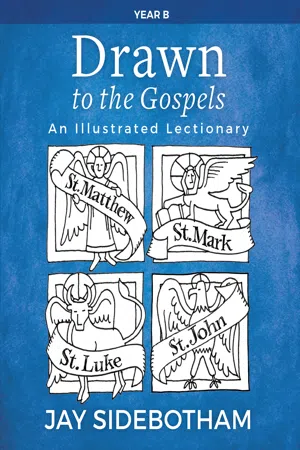
This is a test
- 160 pages
- English
- ePUB (mobile friendly)
- Available on iOS & Android
eBook - ePub
Book details
Book preview
Table of contents
Citations
About This Book
Each week brings a lighthearted opportunity to remember that humor and the gospel are not mutually exclusive.
The Drawn to the Gospels series covers all of the Sundays in the lectionary year, as well as special days such as Christmas, Epiphany, Ash Wednesday, and Ascension Day. Each entry contains a cartoon illustration of the gospel, a short paragraph of introduction, and some engaging questions. The cartoons are scaled so they can be reproduced for bulletins, inserts, or even posters, bringing weekly gospel readings to life. These amusing and original reflections deepen scriptural literacy and engagement among members of the Episcopal Church, including youth groups, and will inspire some fun in the process.
Frequently asked questions
At the moment all of our mobile-responsive ePub books are available to download via the app. Most of our PDFs are also available to download and we're working on making the final remaining ones downloadable now. Learn more here.
Both plans give you full access to the library and all of Perlego’s features. The only differences are the price and subscription period: With the annual plan you’ll save around 30% compared to 12 months on the monthly plan.
We are an online textbook subscription service, where you can get access to an entire online library for less than the price of a single book per month. With over 1 million books across 1000+ topics, we’ve got you covered! Learn more here.
Look out for the read-aloud symbol on your next book to see if you can listen to it. The read-aloud tool reads text aloud for you, highlighting the text as it is being read. You can pause it, speed it up and slow it down. Learn more here.
Yes, you can access Drawn to the Gospels by Jay Sidebotham,Jay Sidebotham in PDF and/or ePUB format, as well as other popular books in Theology & Religion & Biblical Studies. We have over one million books available in our catalogue for you to explore.
Information
Topic
Theology & ReligionSubtopic
Biblical Studies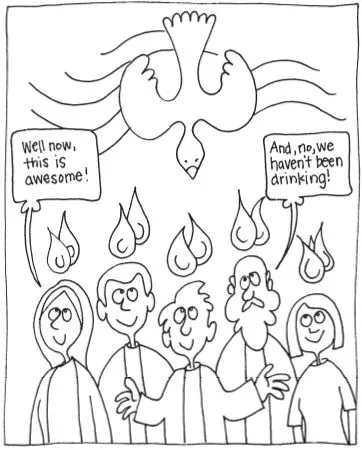
Day of Pentecost
John 15:26–27, 16:4b–15
Notes on This Reading
The early church adopted and adapted a Jewish feast, the feast of Pentecost, to note the day that the Holy Spirit descended on the disciples, filling them with power represented by fire and wind, giving them the gift of many languages, establishing them as a community that in short order would change the world. For that reason, in the Christian tradition, Pentecost has often been called the birthday of the church. This particular event, recorded in chapter 2 of the Acts of the Apostles, was marked by extraordinary events, but the main point was that God was still very much present with the group of disciples after Jesus ascended. They had indeed received the power that they needed to make a difference.
Questions
- Take time to read the story of Pentecost in Acts 2. How does it compare with the readings from the Gospel of John? What’s similar? What’s different?
- In John’s gospel, Jesus promises an advocate to be with his disciples, to strengthen them. What kind of advocate does Jesus send? How does the Holy Spirit act as advocate?
- In Acts, the power comes with a mighty wind. How have you received power to live a life of faith in the world? Where did that power come from?
- What is important about breath and wind in the spiritual life? Note how many religious traditions focus on breath and wind.

Trinity Sunday
John 3:1–17
Notes on This Reading
For this Sunday dedicated to a doctrine of the church, we return to the third chapter of John. There we read about an encounter between Jesus and Nicodemus, an elderly religious leader who comes to Jesus at night to find out what this young teacher was all about. As in other conversations in the Gospel of John, Nicodemus asks a lot of questions and seems kind of clueless. It’s a way to bring the reader in, so that the reader thinks: “I know what Jesus really means.” This rich passage, which we read earlier this year in the season of Lent, includes one of the most famous verses in the Bible (John 3:16). It may be chosen for Trinity Sunday because it makes reference to the three persons of the Trinity—Father, Son, and Holy Spirit. While the doctrine is never explicitly set forth in the New Testament (it’s the result of later Church conversations), this is one of the places that point to its power and meaning.
Questions
- What do you think of Nicodemus? Why does he come to Jesus at night? Is he really busy? Is he coming under cover? Is he embarrassed to be seen with Jesus? Or scared? Have you ever been a bit shy about exploring faith?
- What does it mean that a religious leader wants to pick Jesus’s brain?
- What does it mean to you to be born from above, or born anew, or born again? Have you had any experiences like that?
- Why do you think John 3:16 is so popular? How does John 3:17 help to fill out the meaning of this important verse?
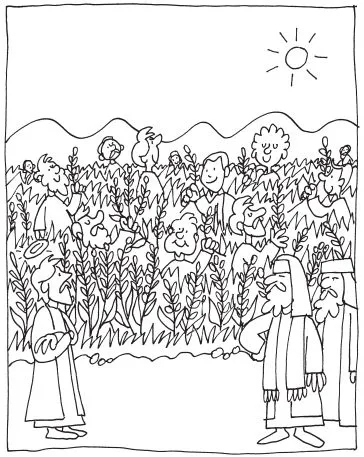
Proper 4
Mark 2:23–3:6
Notes on This Reading
Like the other gospels, a big part of the story in the Gospel of Mark has to do with Jesus’s conflict with the religious authorities of his day. That conflict is in large part what eventually got him killed. Jesus reinterprets some of the most sacred elements of his own tradition, including the observance of the Sabbath, making the point that the Sabbath is made for humankind and not the other way around. He then makes the point that the Sabbath is a day for doing good, even if that violates some of the restrictions of his religious tradition. All of this enrages the religious authorities of his day, setting up a conflict that will find its culmination in the cross.
Questions
- What is your impression of the Pharisees? Can you think of any modern-day equivalents?
- What was their objection to Jesus’s disciples’ actions?
- Do you think that Jesus went out of his way to heal on the Sabbath? Couldn’t he have waited for another day?
- Are there religious traditions we observe that may not necessarily fulfill the message of love and grace that is found at the heart of the gospel?
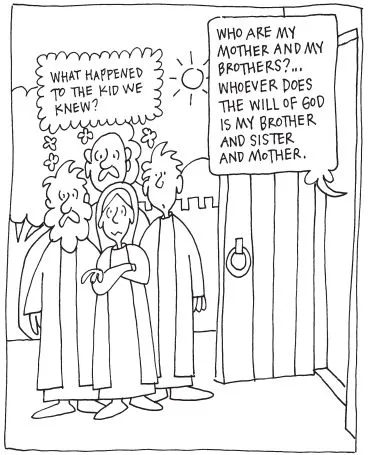
Proper 5
Mark 3:20–35
Notes on This Reading
Many of the gospel stories describe the ways that people try to figure out who Jesus is. He is definitely rocking the boat and people don’t know quite what to make of him. And so they assume he must be evil. He must be of the devil if he doesn’t fit into their categories. That leads Jesus to make a chilling and perplexing comment about sinning against the Holy Spirit, which according to this text is unforgivable. This author is not sure what to make of it, except to note that there is great danger in saying that something which is good and holy and divine is evil. This week’s passage goes on to describe Jesus’s vision of his own family. Who are his people? It may seem harsh but he makes the point that his people are all those who follow him.
Questions
- Why did the people jump to the conclusion that Jesus was of the devil? How would that help them make sense of him?
- Can you think of examples of times when good people were accused of being evil?
- Do you have any thoughts on what it might mean that there is an unforgivable sin? Do you find that unsettling?
- Was Jesus being harsh on his own immediate family? What does this passage say about family values? What does it mean to be part of Jesus’s family?
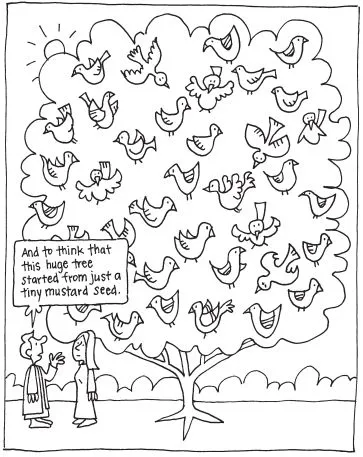
Proper 6
Mark 4:26–34
Notes on This Reading
One of the ways that Jesus taught was through parables, stories that are meant to help us see things in a new way, and perhaps even unsettle our thinking. They were ways of describing the mystery of the Kingdom of God. For Jesus, they often reflected the agricultural nature of the society in which he lived. They also often spoke about how things grow, including faith. So this week we read two parables, one which simply says that growth in the kingdom is a mystery, and the other that says that the kingdom can grow from the smallest of sources. Both of these stories are meant to get us thinking about how faith can grow in our own communities and in our own hearts.
Questions
- Why did Jesus teach in parables? What are the advantages of a teaching method like that?
- The first parable seems to suggest that there is mystery in how the kingdom of God grows, maybe how faith grows. How have you witnessed that kind of growth? Does it strike you as mysterious?
- The second parable seems to suggest that great things can come from small sources. Can you think of any examples of where that is true?
- If you want a deeper appreciation of the power of parables, try your hand at writing one. See what you can tell about God through a story.

Proper 7
Mark 4:35–41
Notes on This Reading
One of the persistent themes in the gospels has to do with Jesus’s ability to calm storms. On the one hand, such power is meant to indicate that he was more than just a great teacher (which he was) but that in some way he could draw on the power of the one who created and sustains all of nature. They may also echo passages from the psalms which speak of God’s power to calm turbulence. Finally, these stories may serve as a parable for the ways that we face all kinds of storms. In early Christian symbolism, the church was pictured as a boat, a safe place in the storm. Such safety is something we still need.
Questions
- What do we learn about Jesus in a story like this? How might our picture of him be different if we didn’t have this theme popping up again and again in the gospels?
- What would the lessons be for the first disciples, those in the boat with Jes...
Table of contents
- Cover Page
- Title Page
- Dedication
- Copyright
- Contents
- Introduction
- Advent
- Christmas
- Epiphany
- Lent
- Easter
- Pentecost
- In Conclusion